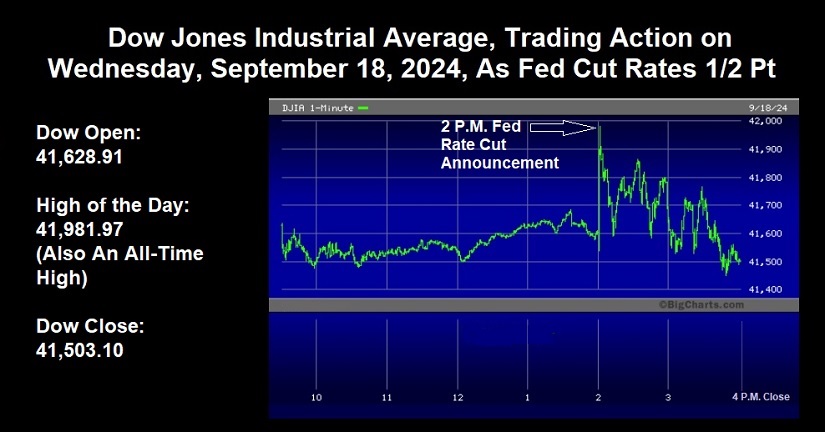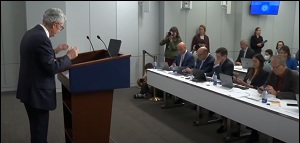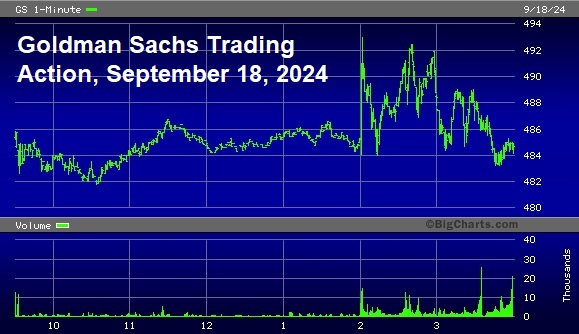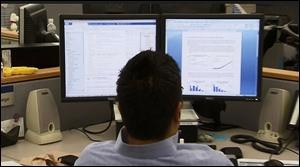By Pam Martens and Russ Martens: September 19, 2024 ~
The Federal Reserve yesterday cut its benchmark interest rate, the Fed Funds rate, for the first time in four years. The cut was by half a point rather than the customary quarter point increments typical of Fed rate moves. Only one member of the Federal Open Market Committee (FOMC), Michelle Bowman, voted against the action. Bowman wanted a quarter point cut according to the FOMC announcement.
A Fed rate cut of a quarter point to a half point was widely anticipated by the market, so the stock market’s wild swings were puzzling to veteran Wall Street watchers.
The FOMC released its written announcement at 2 p.m. As the chart above indicates, the written announcement produced a surge in the Dow Jones Industrial Average to an intraday high of 41,981.97, which was also an all-time high on an intraday basis. But within a few minutes, the Dow had plunged by more than 300 points, then spiked by over 200 points as Fed Chairman Jerome Powell’s press conference got underway at 2:30 p.m.
Wild market gyrations like this, as the Chair of the Fed is about to take the podium, are not in keeping with what Michelle Smith, the long-tenured and detail-oriented Communications Director at the Fed, wants as background noise as the Fed Chair interacts with the press. (See Reporters Who Ask Tough Questions at Fed Press Conferences Have a Habit of Being Disappeared from the Room.)
The Dow gained some ground back as Powell read his prepared statement at his press conference but plunged further as reporters began questioning the Fed Chair. Craig Rugaber, the Federal Reserve and Economics reporter for the Associated Press, asked this question about 11 minutes into the press conference:
“The projections show that the Fed officials expect that the Fed Funds rate to still be above their estimate of long-run neutral by the end of next year. So does that suggest to you that you see rates as restrictive for that entire period? Does that threaten the weakening of the job market you said you’d like to avoid? Or does it suggest that maybe people see the short-run neutral as a little bit higher.”
Powell responded with this:
“I think the way I would really characterize it is this: people write down their estimate – individuals [on the Federal Open Market Committee] do – I think every single person on the Committee, if you ask them what’s your level of certainty around that, and they would say, ‘there’s a wide range where that could fall.’ So I think we don’t know. There are model-based approaches and empirically-based approaches that estimate what the neutral rate will be at any given time but realistically we know it by its works. So that leaves us in a place where we expect in the base case to be continuing to remove restriction and we’ll be looking at the way the economy reacts to that and that will be guiding us in our thinking about the question we’re asking at every meeting, which is – is our policy stance the appropriate one….”
Powell’s press conference ended 50 minutes after it began, at about 3:20 p.m. EDT. Some of the worst damage of the day occurred after the press conference ended, with the Dow moving into negative territory and closing with a loss on the day of 103 points. From its high of the day to its closing price, the Dow had plunged 478.87 points. As Michelle Smith must have noticed, this was not a comforting vote of confidence that Jerome Powell – a lawyer, not an economist – knows what he’s doing. (See, for example, For the First Time in History, the Fed Is Reporting Billions in Losses Weekly; It’s Still Paying High Interest Income to the Mega Banks on Wall Street.)
Two of the components of the Dow Jones Industrial Average, JPMorgan Chase and Goldman Sachs, are megabanks that have an incestuous relationship with the Fed. The Fed is their regulator; their serial source of bailout loans in the trillions of dollars; their trading partner at the New York Fed’s open market operations; and the banks’ executives sit on the New York Fed’s advisory committees, recommending “best practices” for Wall Street megabanks which have a serial history of getting slapped with felony counts by the U.S. Department of Justice, rigging markets and engaging in predatory behavior against their customers. (See watchdog Better Markets’ Rap Sheet Report here.)
And, most dangerous of all, the Fed is the federal agency that just cut in half the amount of capital it said in July of 2023 these megabanks need to hold to operate in a safe and sound manner.
The share prices of Goldman Sachs and JPMorgan Chase also experienced wild swings between the 2 p.m. FOMC statement and the close of trading at 4 p.m. Both megabanks, however, own their own Dark Pools where, bizarrely, they are allowed by the Securities and Exchange Commission to trade their own bank shares in darkness, which might offer a possible explanation as to why they fared better by the closing bell than the Dow index. (See Wall Street Banks Are Trading in Their Own Company’s Stock: How Is This Legal? and Goldman Sachs Is Quietly Trading Stocks In Its Own Dark Pools on 4 Continents.)
The Goldman Sachs’ chart below, showing how its shares swung wildly yesterday afternoon, bears an uncanny resemblance to the Dow chart.
While the megabanks on Wall Street own their own Dark Pools, the New York Fed (the largest of the 12 regional Fed banks) has its own trading desks – one at its lower Manhattan headquarters at 33 Liberty Street and one near the futures market in Chicago. (See Mission Creep or Creepy Mission: The New York Fed’s Trading Desk Has Ballooned to $6.59 Trillion Today from $576 Billion in 2008 and The New York Fed Has Quietly Staffed Up a Second Trading Floor Near the S&P 500 Futures Market in Chicago.)
If all of this has the feel of an institutionalized wealth transfer system instead of an efficient market system worthy of a democracy, please contact your U.S. Senators today. Tell your Senators to hold immediate hearings on the Fed’s non-stop bailouts of the megabanks and demand the restoration of the Glass-Steagall Act, which would separate federally-insured commercial banks from the trading casinos on Wall Street.





